Impact of an Aged Green Roof on Stormwater Quality and First-Flush Dynamics
Abstract
1. Introduction
- (i)
- It provides novel insights into TOC dynamics in an aged GR system, addressing a key gap associated with the influence of substrate aging.
- (ii)
- It introduces a mass-based approach to assess first-flush effects, establishing benchmark parameters specific to GR runoff conditions.
- (iii)
- It applies a probabilistic modeling approach to identify the event-scale probability distributions of TOC, enhancing the reliability and generalizability of water quality models for nature-based solutions.
2. Materials and Methods
2.1. Green Roof and Conventional Roof Pilots
2.2. Data Collection
2.3. Water Quality Analyses
2.4. First-Flush Evaluation Method
2.5. Statistical Data Analyses
3. Results and Discussion
3.1. Runoff Water Quality
3.1.1. Total Organic Carbon—EMC
3.1.2. Total Organic Carbon—Load
3.1.3. pH
3.1.4. Electrical Conductivity
3.1.5. Relationship Between Parameters
3.2. First-Flush Dynamics
3.2.1. First-Flush Green Roof
3.2.2. First-Flush Conventional Roof
3.3. Probabilistic Pattern of the Conventional Roof Runoff Water Quality
4. Conclusions
Author Contributions
Funding
Data Availability Statement
Acknowledgments
Conflicts of Interest
References
- Maniquiz-Redillas, M.; Robles, M.E.; Cruz, G.; Reyes, N.J.; Kim, L.H. First Flush Stormwater Runoff in Urban Catchments: A Bibliometric and Comprehensive Review. Hydrology 2022, 9, 63. [Google Scholar] [CrossRef]
- Meng, F.; Yuan, Q.; Bellezoni, R.A.; Puppim de Oliveira, J.A.; Hu, Y.; Jing, R.; Liu, G.; Yang, Z.; Seto, K.C. The Food-Water-Energy Nexus and Green Roofs in Sao Jose Dos Campos, Brazil, and Johannesburg, South Africa. NPJ Urban Sustain. 2023, 3, 12. [Google Scholar] [CrossRef]
- Kumar, S.; Kumar Vishwakarma, R.; Kumar Tyagi, V.; Kumar, V.; Kazmi, A.A.; Ghosh, N.C.; Sasidharan, S.; Nayak, P.C.; Maurya, N.S.; Hasan, R.; et al. Stormwater Runoff Characterization and Adaptation of Best Management Practices under Urbanization and Climate Change Scenarios. J. Hydrol. 2024, 635, 131231. [Google Scholar] [CrossRef]
- Stovin, V.; Vesuviano, G.; Kasmin, H. The Hydrological Performance of a Green Roof Test Bed under UK Climatic Conditions. J. Hydrol. 2012, 414–415, 148–161. [Google Scholar] [CrossRef]
- Li, Y.; Liu, J. Green Roofs in the Humid Subtropics: The Role of Environmental and Design Factors on Stormwater Retention and Peak Reduction. Sci. Total Environ. 2023, 858, 159710. [Google Scholar] [CrossRef] [PubMed]
- Farah, G.; Pérez, G.; Ballesta, A.; El Bachawati, M. Green Roof Substrates Influencing the Provision of Ecosystem Services: A Review. J. Environ. Chem. Eng. 2024, 12, 114795. [Google Scholar] [CrossRef]
- Chapelle, F. Dissolved Organic Carbon in Groundwater Systems; Groundwater Project: Toronto, ON, Canada, 2022; ISBN 9781774700167. [Google Scholar]
- Müller, A.; Österlund, H.; Marsalek, J.; Viklander, M. The Pollution Conveyed by Urban Runoff: A Review of Sources. Sci. Total Environ. 2020, 709, 136125. [Google Scholar] [CrossRef]
- Aguilar-Torrejón, J.A.; Balderas-Hernández, P.; Roa-Morales, G.; Barrera-Díaz, C.E.; Rodríguez-Torres, I.; Torres-Blancas, T. Relationship, Importance, and Development of Analytical Techniques: COD, BOD, and, TOC in Water—An Overview through Time. SN Appl. Sci. 2023, 5, 118. [Google Scholar] [CrossRef]
- CETESB. Relação Entre Carbono Orgânico Total e Demanda Bioquímica de Oxigênio na Avaliação da Qualidade das Águas Dos Corpos Hídricos do Estado de São Paulo. Available online: https://cetesb.sp.gov.br/aguas-interiores/wp-content/uploads/sites/12/2024/04/Relacao-entre-Carbono-Organico-Total-e-Demanda-Bioquimica-de-Oxigenio-na-Avaliacao-da-Qualidade-das-Aguas-dos-Corpos-Hidricos-do-Estado-de-Sao-Paulo.pdf (accessed on 16 May 2025).
- Hanumesh, M.; Claverie, R.; Séré, G. A Roof of Greenery, but a Sky of Unexplored Relations—Meta-Analysis of Factors and Properties That Affect Green Roof Hydrological and Thermal Performances. Sustainability 2021, 13, 10017. [Google Scholar] [CrossRef]
- Meng, R.; Zhang, Q.; Li, D.; Wang, H. Influence of Substrate Layer Thickness and Biochar on the Green Roof Capacity to Intercept Rainfall and Reduce Pollution in Runoff. Polish J. Environ. Stud. 2021, 30, 4085–4103. [Google Scholar] [CrossRef]
- Lim, H.S.; Segovia, E.; Ziegler, A.D. Water Quality Impacts of Young Green Roofs in a Tropical City: A Case Study from Singapore. Blue-Green Syst. 2021, 3, 145–163. [Google Scholar] [CrossRef]
- Harper, G.E.; Limmer, M.A.; Showalter, W.E.; Burken, J.G. Nine-Month Evaluation of Runoff Quality and Quantity from an Experiential Green Roof in Missouri, USA. Ecol. Eng. 2015, 78, 127–133. [Google Scholar] [CrossRef]
- Iqbal, H.; Garcia-Perez, M.; Flury, M. Effect of Biochar on Leaching of Organic Carbon, Nitrogen, and Phosphorus from Compost in Bioretention Systems. Sci. Total Environ. 2015, 521–522, 37–45. [Google Scholar] [CrossRef] [PubMed]
- Allory, V.; Séré, G.; Ouvrard, S. A Meta-Analysis of Carbon Content and Stocks in Technosols and Identification of the Main Governing Factors. Eur. J. Soil Sci. 2022, 73, e13141. [Google Scholar] [CrossRef]
- Thebuwena, A.C.H.J.; Samarakoon, S.M.S.M.K.; Ratnayake, R.M.C. On the Necessity for Improving Water Efficiency in Commercial Buildings: A Green Design Approach in Hot Humid Climates. Water 2024, 16, 2396. [Google Scholar] [CrossRef]
- Berndtsson, J.C.; Bengtsson, L.; Jinno, K. First Flush Effect from Vegetated Roofs during Simulated Rain Events. Hydrol. Res. 2008, 39, 171–179. [Google Scholar] [CrossRef]
- Bliss, D.J.; Neufeld, R.D.; Ries, R.J. Storm Water Runoff Mitigation Using a Green Roof. Environ. Eng. Sci. 2009, 26, 407–418. [Google Scholar] [CrossRef]
- Mendez, C.B.; Klenzendorf, J.B.; Afshar, B.R.; Simmons, M.T.; Barrett, M.E.; Kinney, K.A.; Kirisits, M.J. The Effect of Roofing Material on the Quality of Harvested Rainwater. Water Res. 2011, 45, 2049–2059. [Google Scholar] [CrossRef]
- Bertrand-Krajewski, J.L.; Chebbo, G.; Saget, A. Distribution of Pollutant Mass vs Volume in Stormwater Discharges and the First Flush Phenomenon. Water Res. 1998, 32, 2341–2356. [Google Scholar] [CrossRef]
- Perera, T.; McGree, J.; Egodawatta, P.; Jinadasa, K.B.S.N.; Goonetilleke, A. New Conceptualisation of First Flush Phenomena in Urban Catchments. J. Environ. Manage. 2021, 281, 111820. [Google Scholar] [CrossRef]
- Strecker, B.E.W.; Quigley, M.M.; Member, A.; Urbonas, B.R.; Jones, J.E.; Clary, J.K. Determining Urban Storm Water BMP Effecttiveness. J. Water Resour. Plan. Manag. 2001, 127, 144–149. [Google Scholar] [CrossRef]
- Dirckx, G.; Vinck, E.; Kroll, S. Stochastic Determination of Combined Sewer Overflow Loads for Decision-Making Purposes and Operational Follow-Up. Water 2022, 14, 1635. [Google Scholar] [CrossRef]
- Ekwule, O.R.; Agunwamba, J.C. Application of the NRCS-Curve Number Method in Humid Tropical Basins of Southeastern Nigeria: A Statistical Analysis. Environ. Syst. Res. 2024, 13, 52. [Google Scholar] [CrossRef]
- Alvares, C.A.; Stape, J.L.; Sentelhas, P.C.; De Moraes Gonçalves, J.L.; Sparovek, G. Köppen’s Climate Classification Map for Brazil. Meteorol. Zeitschrift 2013, 22, 711–728. [Google Scholar] [CrossRef]
- INMET. Climatological Normals of Brazil 1991–2020. Available online: https://portal.inmet.gov.br/normais (accessed on 16 May 2025).
- Pereira-Flores, M.E.; Justino, F.; Rodrigues, J.M.; Boehringer, D.; Melo, A.A.M.; Cursi, A.G.; da Costa Pereira, V.; Pereira, O.G.; Ruiz-Vera, U.M. Seasonal Climate Impact on Brazilian Pasture (Brachiaria Brizantha Cv Marandu): Growth Rate, CO2 Efflux, and Irrigation Strategies. Theor. Appl. Climatol. 2023, 151, 651–666. [Google Scholar] [CrossRef]
- Ferraz, I.L. The Thermal Performance of Green Roof System in Comparison to the Traditional Ceramic Tile Roof System. Master’s Thesis, University of Sao Paulo, Sao Paulo, Brazil, 2012. [Google Scholar]
- Osawa, T.M.; Pereira, M.C.S.; Martins, J.R.S. Error Processing of Water Level Data Measurements by a Low-Cost Ultrasonic Sensor. In Proceedings of the 17th IWA Conference on Small Water and Wastewater Systems (SWWS) and 9th IWA Conference on Resource Oriented Sanitation (ROS), Curitiba, Brazil, 10–14 November 2024; p. 4. [Google Scholar]
- Osawa, T.M.; Pereira, M.C.S.; Leite, B.C.C.; Martins, J.R.S. Low-Cost Diffuse Pollution Monitoring System for Nature-Based Solutions. In Proceedings of the XV Encontro Nacional de Águas Urbanas; ABRH: Recife, Brazil, 2024; pp. 1–10. [Google Scholar]
- Saget, A.; Chebbo, G.; Bertrand-Krajewski, J.-L. The First Flush in Sewer Systems. Water Sci. Technol. 1996, 33, 101–108. [Google Scholar] [CrossRef]
- Pessoa, J.O.; Piccilli, D.G.A.; Persch, C.G.; Tassi, R.; Georgin, J.; Franco, D.S.P.; Yamil, Y.L. Identifying Potential Uses for Green Roof Discharge Based on Its Physical–Chemical-Microbiological Quality. Environ. Sci. Pollut. Res. 2024, 31, 27221–27239. [Google Scholar] [CrossRef] [PubMed]
- Buffam, I.; Mitchell, M.E.; Durtsche, R.D. Environmental Drivers of Seasonal Variation in Green Roof Runoff Water Quality. Ecol. Eng. 2016, 91, 506–514. [Google Scholar] [CrossRef]
- Ouellet, V.; Khamis, K.; Croghan, D.; Hernandez Gonzalez, L.M.; Rivera, V.A.; Phillips, C.B.; Packman, A.I.; Miller, W.M.; Hawke, R.G.; Hannah, D.M.; et al. Green Roof Vegetation Management Alters Potential for Water Quality and Temperature Mitigation. Ecohydrology 2021, 14, e2321. [Google Scholar] [CrossRef]
- Zhang, Q.; Miao, L.; Wang, X.; Liu, D.; Zhu, L.; Zhou, B.; Sun, J.; Liu, J. The Capacity of Greening Roof to Reduce Stormwater Runoff and Pollution. Landsc. Urban Plan. 2015, 144, 142–150. [Google Scholar] [CrossRef]
- Bouzouidja, R.; Rousseau, G.; Galzin, V.; Claverie, R.; Lacroix, D.; Séré, G. Green Roof Ageing or Isolatic Technosol’s Pedogenesis? J. Soils Sediments 2018, 18, 418–425. [Google Scholar] [CrossRef]
- Zhang, W.; Tao, K.; Sun, H.; Che, W. Influence of Urban Runoff Pollutant First Flush Strength on Bioretention Pollutant Removal Performance. Water Sci. Technol. 2022, 86, 1478–1495. [Google Scholar] [CrossRef] [PubMed]
- Gnecco, I.; Palla, A.; Lanza, L.G.; La Barbera, P. The Role of Green Roofs as a Source/Sink of Pollutants in Storm Water Outflows. Water Resour. Manag. 2013, 27, 4715–4730. [Google Scholar] [CrossRef]
- Xiong, W.; Li, J.; Wang, H.; Wu, Y.; Li, D.; Xue, J. Biochar Addition and the Runoff Quality of Newly Constructed Green Roofs: A Field Study. Sustainability 2023, 15, 4081. [Google Scholar] [CrossRef]
- ABNT NBR 15.527:2007; Rainwater—Catchment of roofs in urban areas for non-potable purposes—Requirements. Brazilian Technical Standards Association: Sao Paolo, Brazil, 2007.
- Sosa Echeverría, R.; Alarcón Jiménez, A.L.; Torres Barrera, M.d.C.; Sánchez Alvarez, P.; Granados Hernandez, E.; Vega, E.; Jaimes Palomera, M.; Retama, A.; Gay, D.A. Nitrogen and Sulfur Compounds in Ambient Air and in Wet Atmospheric Deposition at Mexico City Metropolitan Area. Atmos. Environ. 2023, 292, 119411. [Google Scholar] [CrossRef]
- Santana, T.C.; Guiselini, C.; Cavalcanti, S.D.L.; Silva, M.V.d.; Vigoderis, R.B.; Santos Júnior, J.A.; Moraes, A.S.; Jardim, A.M.d.R.F. Quality of Rainwater Drained by a Green Roof in the Metropolitan Region of Recife, Brazil. J. Water Process Eng. 2022, 49, 102953. [Google Scholar] [CrossRef]
- Gomes, Y.R.M.; dos Santos, S.M.; de Macedo, P.M.T. Effects of Ecological Roofs in Water Quality: An Experimental Study over a Humid Tropical Climate. Sustain. Water Resour. Manag. 2023, 9, 17. [Google Scholar] [CrossRef]
- Ekanayake, D.; Aryal, R.; Hasan Johir, M.A.; Loganathan, P.; Bush, C.; Kandasamy, J.; Vigneswaran, S. Interrelationship among the Pollutants in Stormwater in an Urban Catchment and First Flush Identification Using UV Spectroscopy. Chemosphere 2019, 233, 245–251. [Google Scholar] [CrossRef]
- Gao, Z.; Zhang, Q.; Wang, Y.; Dzakpasu, M.; Wang, X.C. Contaminant Distribution and Migration in Roofing Rainwater: Implications for Sustainable Utilization and Pollution Control. J. Water Process Eng. 2024, 61, 105298. [Google Scholar] [CrossRef]
- Oduber, F.; Calvo, A.I.; Blanco-Alegre, C.; Castro, A.; Alves, C.; Cerqueira, M.; Lucarelli, F.; Nava, S.; Calzolai, G.; Martin-Villacorta, J.; et al. Towards a Model for Aerosol Removal by Rain Scavenging: The Role of Physical-Chemical Characteristics of Raindrops. Water Res. 2021, 190, 116758. [Google Scholar] [CrossRef]
- Gmach, M.R.; Cherubin, M.R.; Kaiser, K.; Cerri, C.E.P. Processes That Influence Dissolved Organic Matter in the Soil: A Review. Sci. Agric. 2020, 77, e20180164. [Google Scholar] [CrossRef]
- De Buyck, P.J.; Van Hulle, S.W.H.; Dumoulin, A.; Rousseau, D.P.L. Roof Runoff Contamination: A Review on Pollutant Nature, Material Leaching and Deposition; Springer: Dordrecht, The Netherlands, 2021; Volume 20, ISBN 0123456789. [Google Scholar]
- Zhang, Q.; Liu, W.; Gao, Z.; Geng, J.; Dzakpasu, M.; Wang, X.C. Advanced Treatment of First Flush Roof Runoff via a Dry-Wet Polymorphic Constructed Wetland System: Performance and Mechanistic Insights. Environ. Res. 2025, 269, 120918. [Google Scholar] [CrossRef]
- Boonrit, K.; Anusontpornperm, S.; Thanachit, S.; Jindaluang, W. Fractionated Organic Carbon in Relation to Soil Aggregates and Other Soil Properties in Humid, Tropical Lowland, Salt-Affected Soils. Agric. Nat. Resour. 2024, 58, 111–128. [Google Scholar] [CrossRef]
- McCabe, K.M.; Smith, E.M.; Lang, S.Q.; Osburn, C.L.; Benitez-Nelson, C.R. Particulate and Dissolved Organic Matter in Stormwater Runoff Influences Oxygen Demand in Urbanized Headwater Catchments. Environ. Sci. Technol. 2021, 55, 952–961. [Google Scholar] [CrossRef] [PubMed]
- Morgan, D.; Johnston, P.; Osei, K.; Gill, L. The Influence of Particle Size on the First Flush Strength of Urban Stormwater Runoff. Water Sci. Technol. 2017, 76, 2140–2149. [Google Scholar] [CrossRef] [PubMed]
- Zhang, W.; Qu, P.; Sun, H.; Che, W. Assessing the Characteristics of Different-Sized Particles in the First Flush of Roof Runoff. Water Sci. Technol. 2023, 87, 2265–2276. [Google Scholar] [CrossRef]
- Charlebois, B.; Wittbold, P.; Reckhow, D.; Kumpel, E. Effective First Flush Volumes in Experimental Household-Scale Rainwater Catchment Systems. Aqua Water Infrastructure, Ecosyst. Soc. 2023, 72, 814–826. [Google Scholar] [CrossRef]
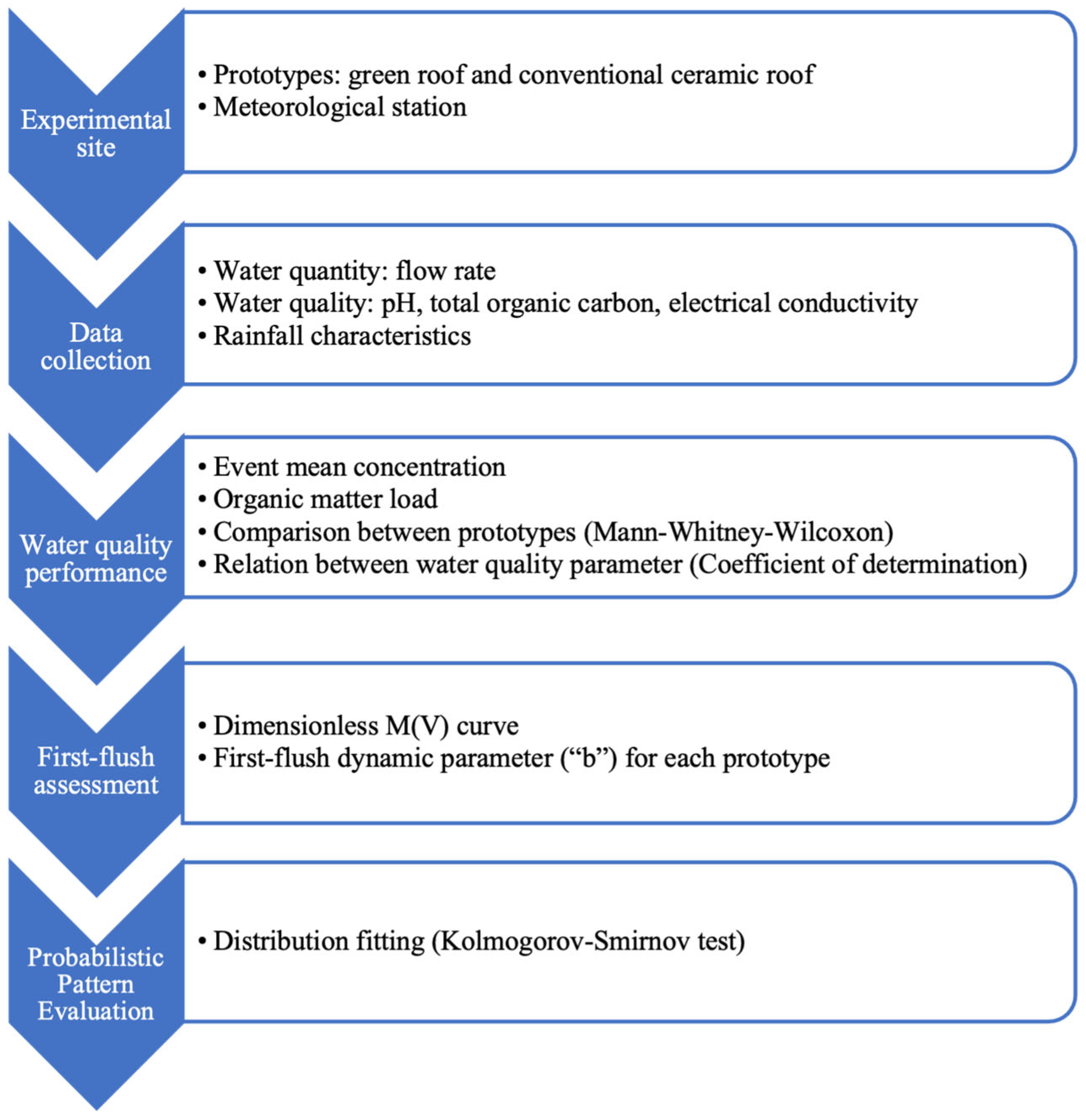
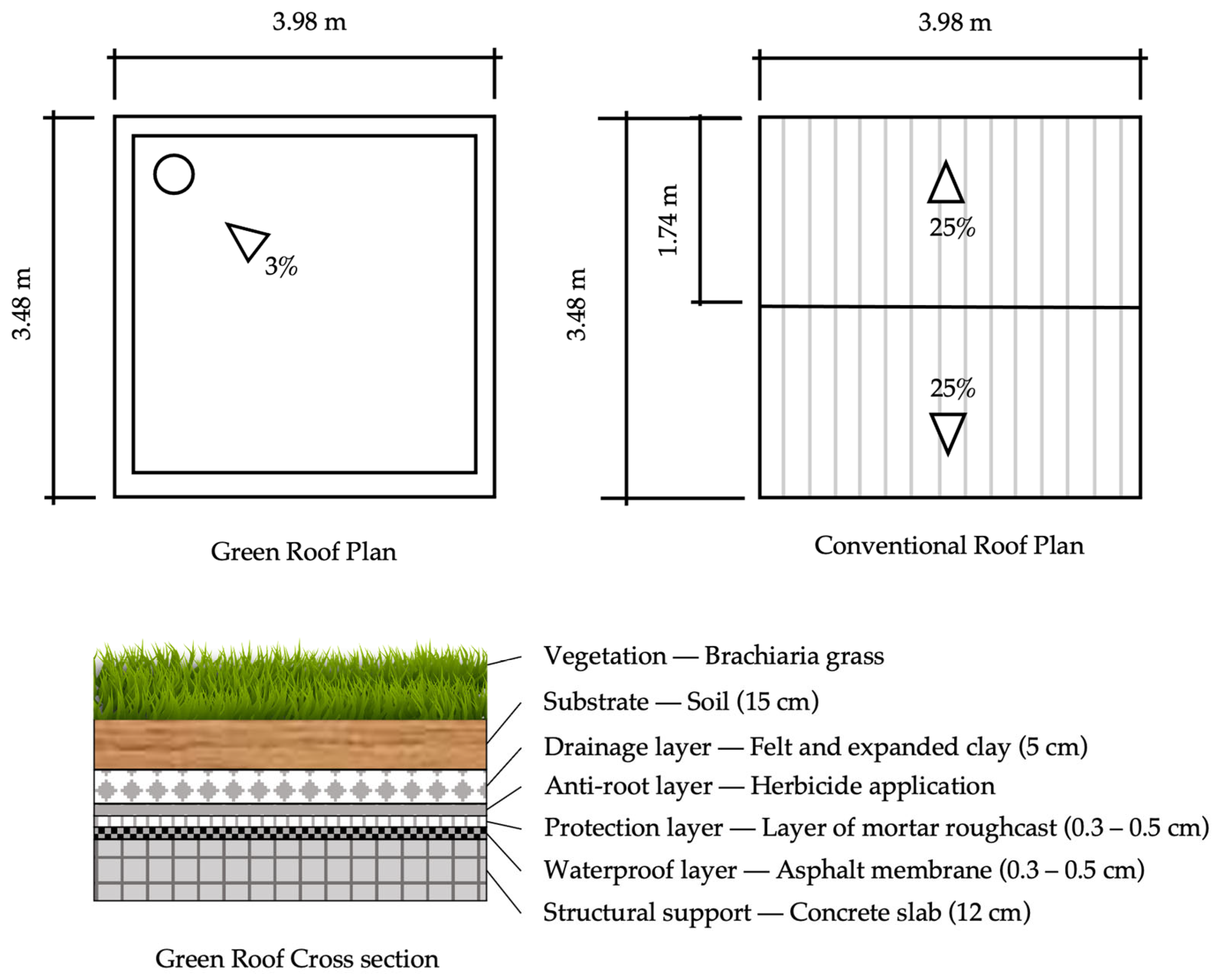
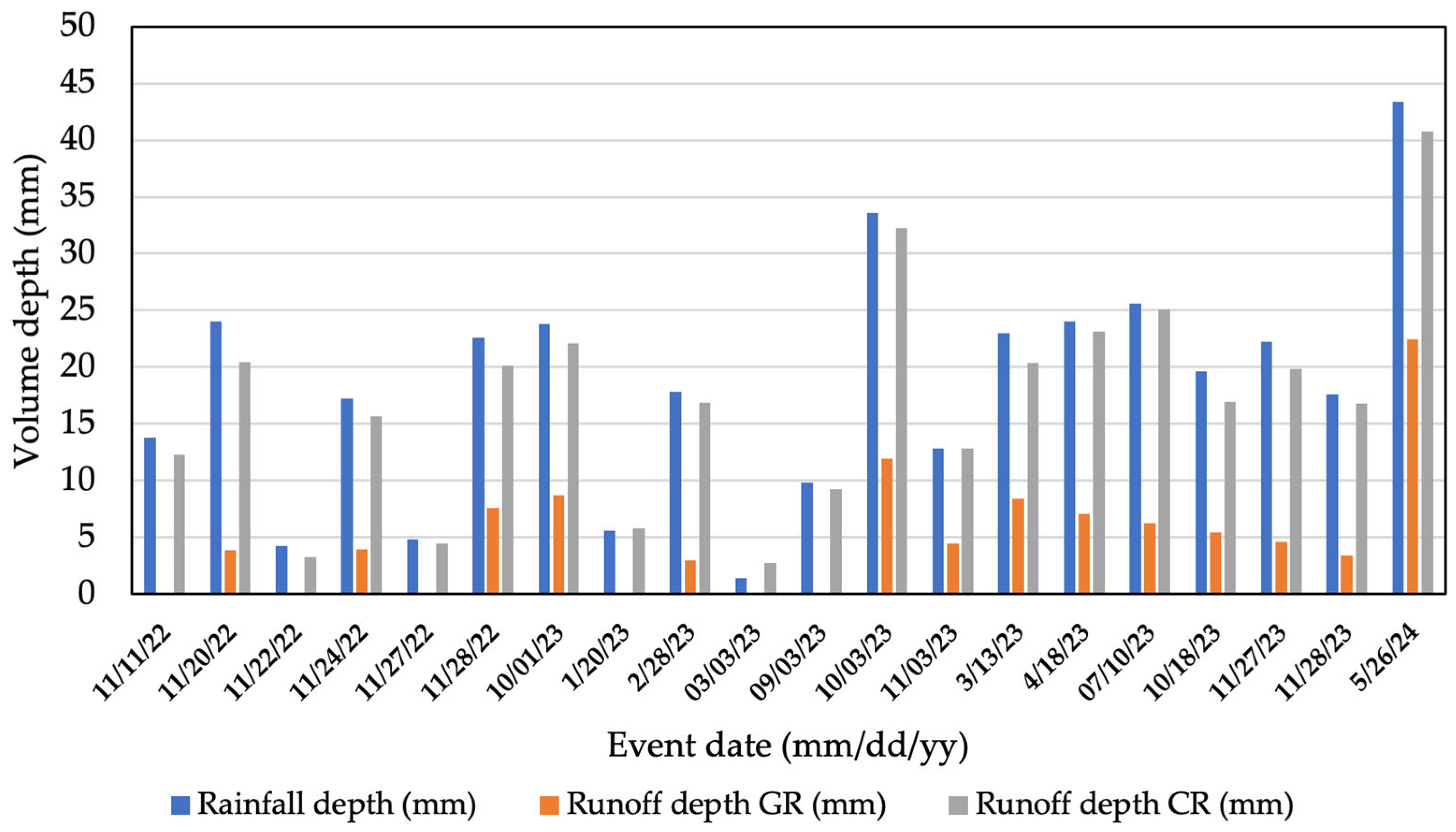



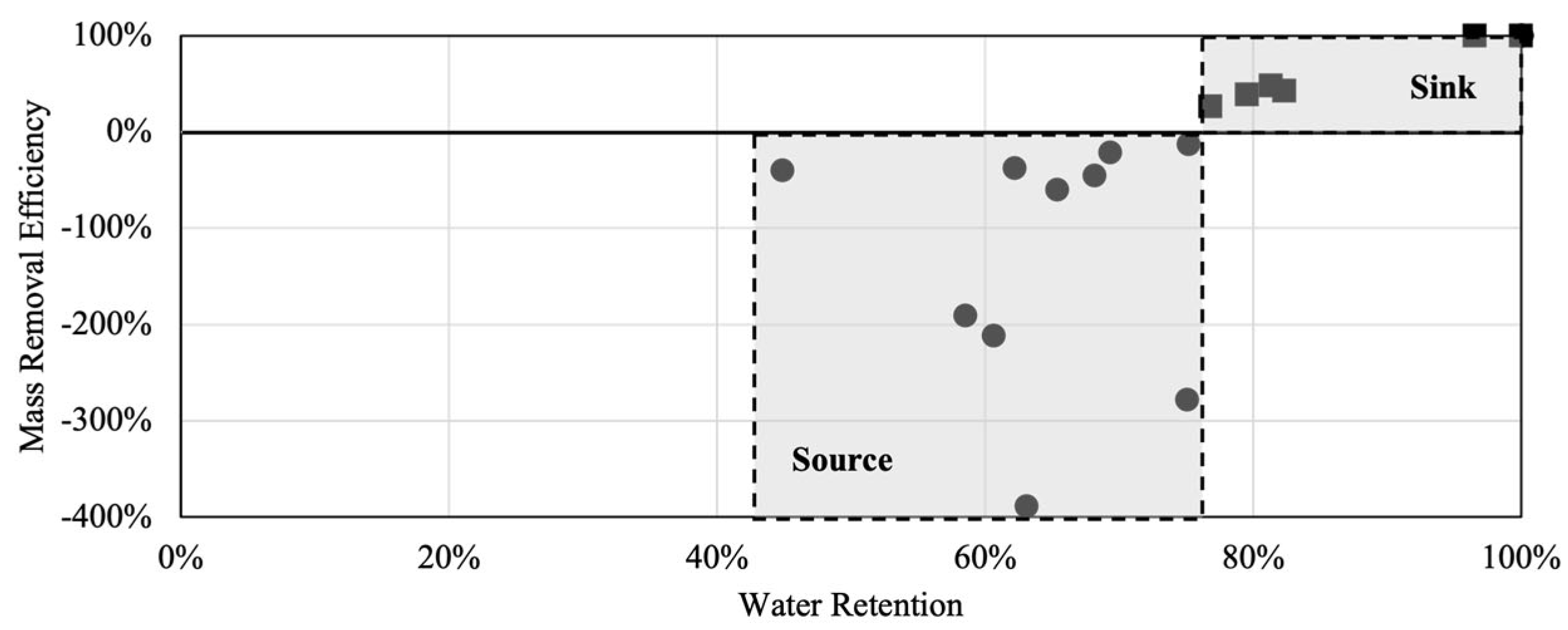


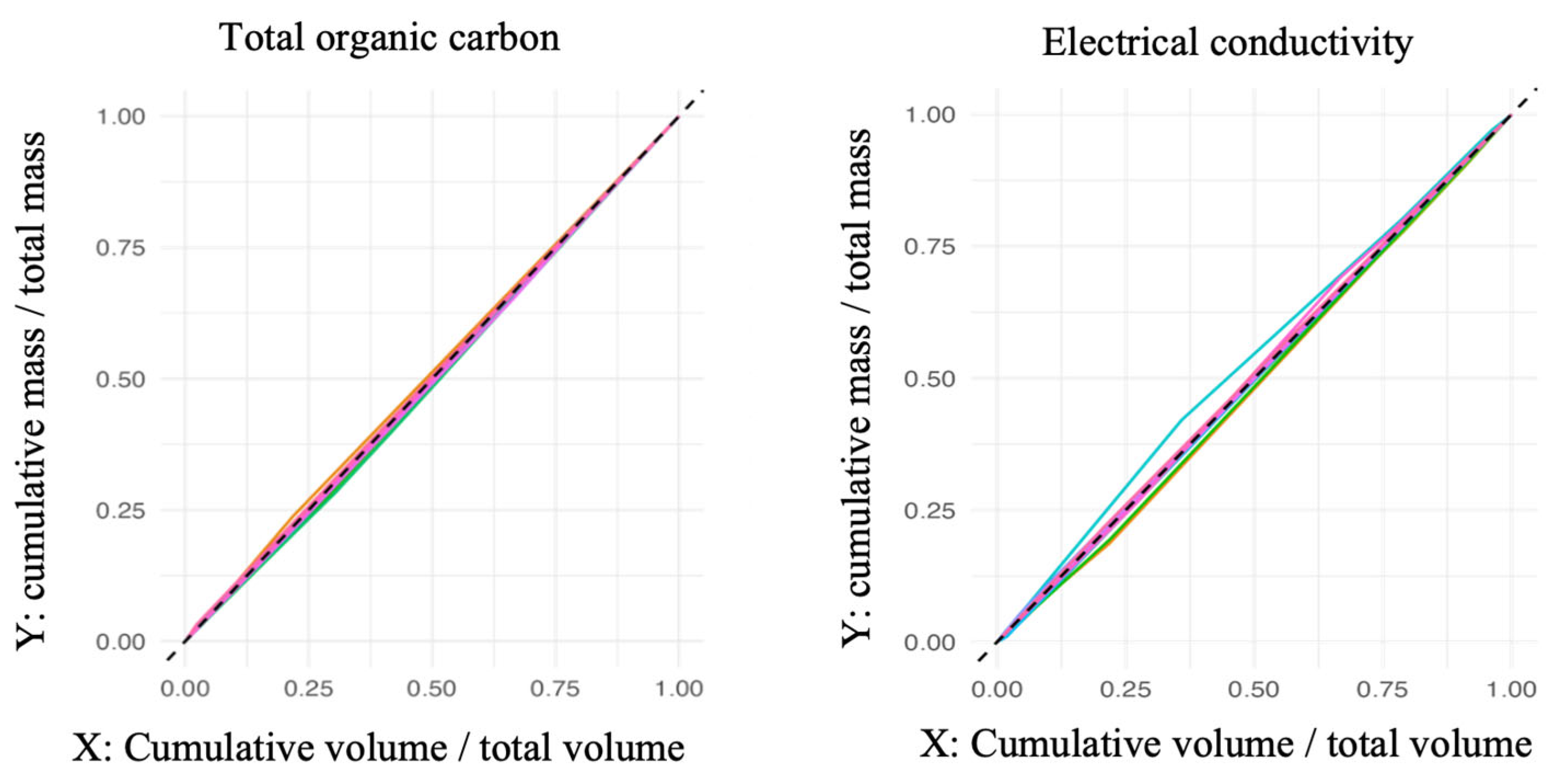
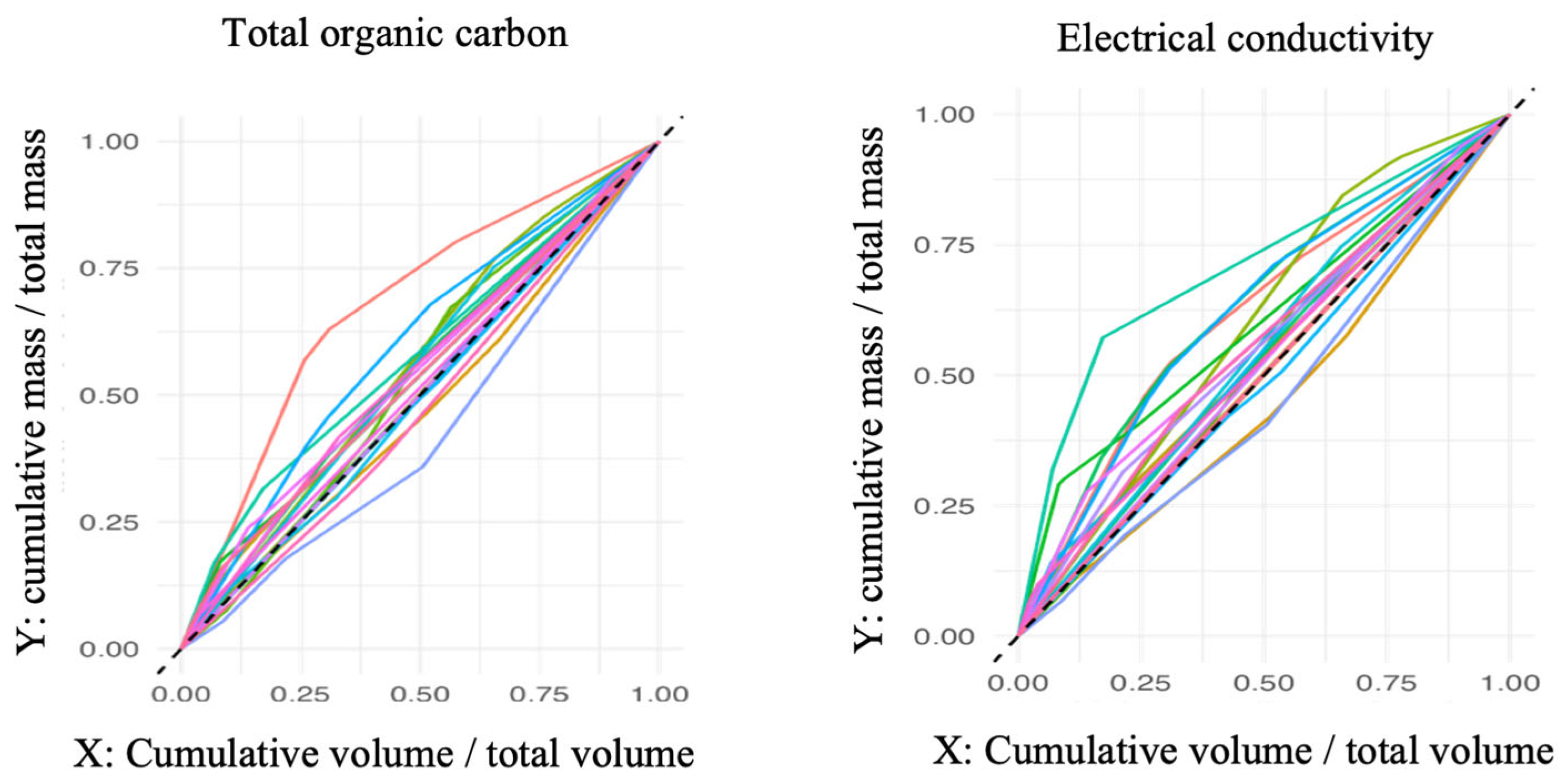
| Zone | Parameter b |
|---|---|
| 1 | <0.185 |
| 2 | 0.185–0.862 |
| 3 | 0.862–1 |
| 4 | 1–1.159 |
| 5 | 1.159–1.539 |
| 6 | >5.395 |
| Water Quality Parameters | GR | CR | Mann–Whitney—Wilcoxon Test (GR × CR) | |||||
|---|---|---|---|---|---|---|---|---|
| Average | Median | Average | Median | Average | Median | p-Value | Difference | |
| 202 | 138 | 94 | 78 | 2.1 | 1.8 | 0.004 | Yes | |
| 21.92 | 21.96 | 5.67 | 5.12 | 3.9 | 4.3 | 0.000 | Yes | |
| Electrical Conductivity | 122 | 130 | 22 | 17 | 5.5 | 7.6 | 0.000 | Yes |
| pH | 7.0 | 7.0 | 5.9 | 5.8 | - | - | 0.000 | Yes |
| Zone | Parameter b | CR | GR | ||
|---|---|---|---|---|---|
| EC | TOC | EC | TOC | ||
| 1 | <0.185 | 0% | 0% | 0% | 0% |
| 2 | 0.185–0.862 | 40% | 36% | 0% | 0% |
| 3 | 0.862–1 | 48% | 40% | 53% | 29% |
| 4 | 1–1.159 | 12% | 20% | 47% | 71% |
| 5 | 1.159–1.539 | 0% | 4% | 0% | 0% |
| Conventional Roof | |||||
|---|---|---|---|---|---|
| Parameter | Distribution probability (p-values) | ||||
| 1st (Best Fit) | 2nd | 3rd | 4th | 5th (Worst Fit) | |
| Weib (0.532) | Norm (0.431) | Gamma (0.411) | Lognorm (0.409) | Exp (0.000) | |
| Weib (0.779) | Norm (0.734) | Gamma (0.501) | Lognorm (0.389) | Exp (0.000) | |
| Lognorm (0.979) | Gamma (0.902) | Weib (0.763) | Exp (0.359) | Norm (0.235) | |
| Weib (0.920) | Norm (0.918) | Gamma (0.880) | Lognorm (0.871) | Exp (0.202) | |
| EC | Weib (0.941) | Gamma (0.930) | Lognorm (0.760) | Norm (0.623) | Exp (0.330) |
| pH | Lognorm (0.863) | Gamma (0.859) | Norm (0.851) | Weib (0.471) | Exp (0.000) |
| Green Roof | |||||
|---|---|---|---|---|---|
| Parameter | Distribution probability (p-values) | ||||
| 1st (Best Fit) | 2nd | 3rd | 4th | 5th (Worst Fit) | |
| Lognorm (0.420) | Norm (0.391) | Gamma (0.410) | Weib (0.235) | Exp (0.000) | |
| Weib (0.680) | Norm (0.350) | Gamma (0.346) | Lognorm (0.344) | Exp (0.000) | |
| Lognorm (0.503) | Exp (0.340) | Gamma (0.195) | Weib (0.213) | Norm (0.037) | |
| Norm (0.999) | Lognorm (0.998) | Gamma (0.998) | Weib (0.983) | Exp (0.001) | |
| EC | Weib (0.735) | Norm (0.602) | Gamma (0.365) | Lognorm (0.277) | Exp (0.008) |
| pH | Norm (0.788) | Gamma (0.788) | Lognorm (0.787) | Weib (0.552) | Exp (0.000) |
Disclaimer/Publisher’s Note: The statements, opinions and data contained in all publications are solely those of the individual author(s) and contributor(s) and not of MDPI and/or the editor(s). MDPI and/or the editor(s) disclaim responsibility for any injury to people or property resulting from any ideas, methods, instructions or products referred to in the content. |
© 2025 by the authors. Licensee MDPI, Basel, Switzerland. This article is an open access article distributed under the terms and conditions of the Creative Commons Attribution (CC BY) license (https://creativecommons.org/licenses/by/4.0/).
Share and Cite
Osawa, T.M.; Pereira, M.C.S.; Leite, B.C.C.; Martins, J.R.S. Impact of an Aged Green Roof on Stormwater Quality and First-Flush Dynamics. Buildings 2025, 15, 1763. https://doi.org/10.3390/buildings15111763
Osawa TM, Pereira MCS, Leite BCC, Martins JRS. Impact of an Aged Green Roof on Stormwater Quality and First-Flush Dynamics. Buildings. 2025; 15(11):1763. https://doi.org/10.3390/buildings15111763
Chicago/Turabian StyleOsawa, Thiago Masaharu, Maria Cristina Santana Pereira, Brenda Chaves Coelho Leite, and José Rodolfo Scarati Martins. 2025. "Impact of an Aged Green Roof on Stormwater Quality and First-Flush Dynamics" Buildings 15, no. 11: 1763. https://doi.org/10.3390/buildings15111763
APA StyleOsawa, T. M., Pereira, M. C. S., Leite, B. C. C., & Martins, J. R. S. (2025). Impact of an Aged Green Roof on Stormwater Quality and First-Flush Dynamics. Buildings, 15(11), 1763. https://doi.org/10.3390/buildings15111763






